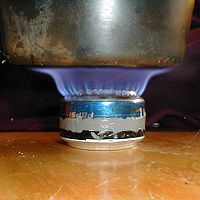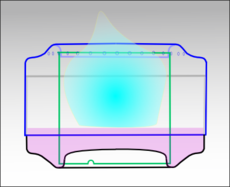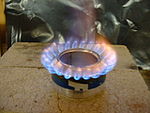
Beverage-can stove
Encyclopedia

Portable stove
A portable stove is a cooking stove specially designed to be portable and lightweight, as for camping or picnicking, or for use in remote locations where an easily transportable means of cooking or heating is needed...
. The simple design is made entirely from aluminium cans and burns alcohol
Alcohol
In chemistry, an alcohol is an organic compound in which the hydroxy functional group is bound to a carbon atom. In particular, this carbon center should be saturated, having single bonds to three other atoms....
. Countless variations on the basic design exist.
Total weight, including a windscreen/stand, can be less than one ounce (30 g). The design is popular with ultralight backpackers
Ultralight backpacking
Ultralight backpacking is a style of backpacking that emphasizes carrying the lightest and simplest kit safely possible for a given trip. Base pack weight is reduced as much as safely possible, though reduction of the weight of...
due to its low cost and lighter weight than most commercial stoves. This advantage may be lost on long hiking
Hiking
Hiking is an outdoor activity which consists of walking in natural environments, often in mountainous or other scenic terrain. People often hike on hiking trails. It is such a popular activity that there are numerous hiking organizations worldwide. The health benefits of different types of hiking...
trips, where a lot of fuel is packed, since alcohol has less energy per weight as some other stove fuels.
History and design
The basic design dates back more than a century. It consists of a double-wall gas generator, a perforated burner ring, and an inner preheat chamber. A similar design was patented in 1904 by New York coppersmithCoppersmith
A coppersmith, also known as a redsmith, is a person who makes artifacts from copper. The term redsmith comes from the colour of copper....
J. Heinrichs. Trangia
Trangia
Trangia is a trademark for a line of alcohol-burning portable stoves manufactured by Swedish company Trangia AB in Trångsviken. These stoves are designed primarily for backpackers, with a focus on light weight, durability and simple design...
has been selling a commercial version of the design since 1925, and Safesport marketed a stainless-steel stove in the 1990s. The Trangia stove burner is made from brass, although all the other associated parts that come with it are aluminium
Aluminium
Aluminium or aluminum is a silvery white member of the boron group of chemical elements. It has the symbol Al, and its atomic number is 13. It is not soluble in water under normal circumstances....
. A plastic bag is provided for the burner, so that when packed away the two dissimilar metals do not corrode
Corrosion
Corrosion is the disintegration of an engineered material into its constituent atoms due to chemical reactions with its surroundings. In the most common use of the word, this means electrochemical oxidation of metals in reaction with an oxidant such as oxygen...
.
In the unpressurized open-top design the double wall acts as a gas generator, transferring heat from the flame to the fuel. This effect enhances combustion, producing more heat than other passive designs. The inner wall also creates a convenient preheat chamber for starting the stove. Once the fuel has warmed up, its vapor will travel up the hollow wall, pass through the perforations, and form a ring of flame. This improves air/fuel mixing and therefore combustion. Vapor also rises from the center of the stove, but will pass through the ring of flame for efficient combustion as long as a pot is over the stove. Other pressurized designs aim for efficient combustion through closing the fuel chamber after filling, or by filling through the gas-jet holes.
A wick may be inserted into the hollow wall, where it will draw fuel upwards closer to the hot parts of the burner. Evaporating fuel from the wick removes heat from the top parts of the burner and subsequently the fuel at the bottom receives less heat. This slows down evaporation through the center while increasing the gas pressure inside the wall, spreading the ring of flame outwards while the center of the burner produces almost no flame, leading to a more controlled burn and faster starting. Suitable wick materials include fiberglass or cotton cloth. The wick will not burn because the evaporating fuel keeps it cool, and the pressure inside prevents air from entering the hollow until the burner can no longer produce enough gas to support a flame.
 |
 |
 |
Aluminium-can construction
The stove is made from two aluminiumAluminium
Aluminium or aluminum is a silvery white member of the boron group of chemical elements. It has the symbol Al, and its atomic number is 13. It is not soluble in water under normal circumstances....
can bottoms. An inner wall is cut and rolled from the can material. A ring of holes is pierced into the top with a pin. Parts are glued with high-temperature epoxy
J-B Weld
The J-B Weld Company is an international company that produces epoxy products. The home office is based in Sulphur Springs, Texas . Also, J-B WELD is the name of their flagship product: a specialized, high-temperature epoxy adhesive for use in bonding materials together...
, or sealed with thermal foil tape, although this is not strictly necessary. Total height is less than two inches (50 mm), though dimensions may be increased to hold more fuel or decreased to take up even less space.
The choice of aluminium has several advantages—light weight, low cost, and good thermal conductivity
Thermal conductivity
In physics, thermal conductivity, k, is the property of a material's ability to conduct heat. It appears primarily in Fourier's Law for heat conduction....
to aid vaporization of fuel. Alternative construction materials have been used, including stoves made of tin cans such as cat food tins, tuna cans, and juice cans—the basic design is very similar. Windscreens/stands can be fabricated from tin can
Tin can
A tin can, tin , steel can, or a can, is a sealed container for the distribution or storage of goods, composed of thin metal. Many cans require opening by cutting the "end" open; others have removable covers. Cans hold diverse contents: foods, beverages, oil, chemicals, etc."Tin" cans are made...
s, cut to size with ventilation holes added.
Operation and performance
Each stove is designed for one or two people. When used to cook larger meals (greater than 2 cupCooking weights and measures
In recipes, quantities of ingredients may be specified by mass, by volume, or by count.For most of history, most cookbooks did not specify quantities precisely, instead talking of "a nice leg of spring lamb", a "cupful" of lentils, a piece of butter "the size of a walnut", and "sufficient" salt...
s (0.5 litre
Litre
pic|200px|right|thumb|One litre is equivalent to this cubeEach side is 10 cm1 litre water = 1 kilogram water The litre is a metric system unit of volume equal to 1 cubic decimetre , to 1,000 cubic centimetres , and to 1/1,000 cubic metre...
s)), it is less efficient than a more-powerful stove which delivers more heat to a pot. This is because a longer cooking time is required, during which more heat is lost to the surroundings. A more powerful, pressurized version is shown below.
To use the stove, a small amount of fuel is poured into the stove and ignited. The pot is then placed above the stove, on a windscreen or stand. The flame is small at first, only burning from the inner chamber. Once the fuel has warmed up (requiring about one minute) its vapor will pass through the perforations and form a ring of flame. Enough heat
Heat
In physics and thermodynamics, heat is energy transferred from one body, region, or thermodynamic system to another due to thermal contact or thermal radiation when the systems are at different temperatures. It is often described as one of the fundamental processes of energy transfer between...
from the flame is passed to the fuel to maintain full combustion
Combustion
Combustion or burning is the sequence of exothermic chemical reactions between a fuel and an oxidant accompanied by the production of heat and conversion of chemical species. The release of heat can result in the production of light in the form of either glowing or a flame...
until the fuel runs out.
Ratings
- Time to boil 2 cups (500 ml): ~12 minutes (45 ml of fuel)
- Time to boil 4 cups (1 l): ~24 minutes (90 ml of fuel)
- Burn time: ~16 minutes (60 ml/4 tablespoons of fuel)
Comparison with other stoves
The stove can outperform some commercial models in cold or high-altitude environments, where propanePropane
Propane is a three-carbon alkane with the molecular formula , normally a gas, but compressible to a transportable liquid. A by-product of natural gas processing and petroleum refining, it is commonly used as a fuel for engines, oxy-gas torches, barbecues, portable stoves, and residential central...
and butane
Butane
Butane is a gas with the formula C4H10 that is an alkane with four carbon atoms. The term may refer to any of two structural isomers, or to a mixture of them: in the IUPAC nomenclature, however, butane refers only to the unbranched n-butane isomer; the other one being called "methylpropane" or...
canisters might fail. Roland Mueser, in Long-Distance Hiking, surveyed hikers on the Appalachian Trail
Appalachian Trail
The Appalachian National Scenic Trail, generally known as the Appalachian Trail or simply the AT, is a marked hiking trail in the eastern United States extending between Springer Mountain in Georgia and Mount Katahdin in Maine. It is approximately long...
and found that this stove was the only design with a zero-percent failure rate.
Fuel usage (by weight) is about fifty percent greater than a butane/propane stove. Can stoves weigh less than an ounce, compared with three ounces for the lightest gas stoves. Many commercial stoves also require special fuel canisters, adding to overall stove weight. No such canisters are necessary in a can stove; denatured alcohol can be carried in virtually any lightweight container, such as a plastic soda bottle. The weight advantage of the beverage-can stove is diminished by the greater fuel consumption (especially on longer hikes), but may still be offset by its reliability and simplicity.
Other attributes of the beverage-can stove are its nearly silent operation and its suitability as an emergency backup. Denatured alcohol is a (relatively) environmentally-friendly fuel that does not leave a residue of soot
Soot
Soot is a general term that refers to impure carbon particles resulting from the incomplete combustion of a hydrocarbon. It is more properly restricted to the product of the gas-phase combustion process but is commonly extended to include the residual pyrolyzed fuel particles such as cenospheres,...
, although it is toxic to drink. (Pure ethanol
Ethanol
Ethanol, also called ethyl alcohol, pure alcohol, grain alcohol, or drinking alcohol, is a volatile, flammable, colorless liquid. It is a psychoactive drug and one of the oldest recreational drugs. Best known as the type of alcohol found in alcoholic beverages, it is also used in thermometers, as a...
is rarely used as stove fuel in the United States, since it is usually subject to a liquor tax.) Denatured alcohol is commonly available at camping outfitters and hardware stores. These stoves operate marginally on 90% isopropyl alcohol
Isopropyl alcohol
Isopropyl alcohol is a common name for a chemical compound with the molecular formula C3H8O. It is a colorless, flammable chemical compound with a strong odor...
, poorly on 70% and not at all with 50%. Water typically cannot be boiled with isopropyl.
Unsealed alcohol stoves are inherently dangerous, since spilling is possible and the fuel burns with a nearly invisible flame. Trangia offers an anti-flashback fuel bottle with an auto-shut-off pourer. If a spill occurs the best course of action is to step back and let the alcohol burn up.
Variations


Inverted two-piece : Smaller and lighter than the standard version; difficult to fill
Side-burner : Doubles as its own pot stand (holes are in the side). A tight-fitting pot can increase fuel pressure
Pressurized : A more powerful version, but heavier and more difficult to make. The stove is sealed with a thumbscrew after filling with fuel; this allows the stove to control the rate of heat output. An additional base is used to hold fuel for preheating
Back-Pressured : Back-pressured stoves simplify the pressurized design by eliminating the thumbscrew and the base needed for preheating, while still controlling the rate of energy output
Insulated : A variation on the standard design, with an inner wall and insulated with fiberglass
Other : Numerous designs in use
Multiple-unit : When cooking for a larger number of people, nothing prevents the use of more than one unit under the same pot
Safety issues
The Boy Scouts of AmericaBoy Scouts of America
The Boy Scouts of America is one of the largest youth organizations in the United States, with over 4.5 million youth members in its age-related divisions...
now prohibits "equipment that is handcrafted, homemade, modified, or installed beyond the manufacturer’s stated design limitations or use. Examples include alcohol-burning 'can' stoves, smudge pot
Smudge pot
A smudge pot is an oil-burning device used to prevent frost on fruit trees. Condensation of water vapor on particulate soot prevents condensation on plants and raises air temperature very slightly. Usually a smudge pot has a large round base with a chimney coming out of the middle of the base...
s, improperly installed heaters, and propane burners with their regulators removed."

